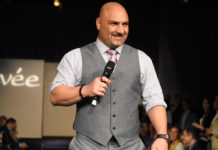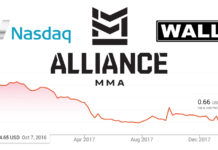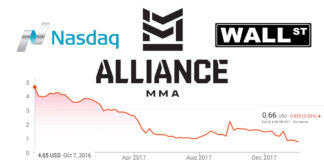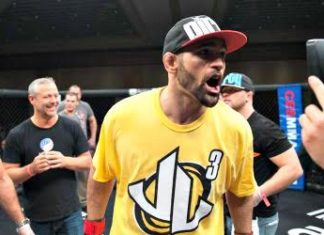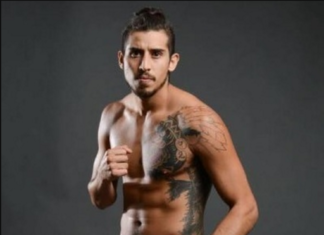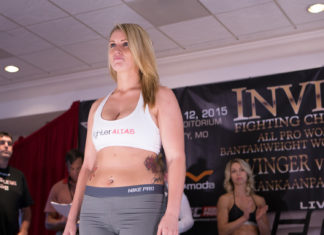Well, it’s official — “Filthy” Tom Lawlor doesn’t get special treatment as a fighter, to say the least.
Lawlor, a 33-year-old, 11-fight UFC veteran became the seventh fighter to be handed a two-year USADA ban last week after he tested positive for ostarine on October 10 last year. The Ultimate Fighter Season 8 veteran spoke with Ariel Helwani on ‘The MMA Hour’ Monday to talk about his anti-doping violation, a request made by USADA, and what his next career move will be if it isn’t a return to the cage.
Even though ‘Filthy’ Tom says that Jeff Novitzky, the UFC Vice President of Athlete Health and Performance, was very open and accessible in the wake of his positive test, USADA and the UFC expected Lawlor to pay for some of the advanced substance testing that was required for the review process. Although he ultimately wasn’t forced to pay in this instance, Lawlor got the vibe that in the future if something like that were to happen he wouldn’t be so lucky.
“I have got a life I’ve got to worry about, regardless of UFC/USADA,” Lawlor told Helwani on Monday, noting that it costs $2700 to go to arbitration.
He also claimed that he did have the money further pursue his anti-doping case — but without any hard evidence he felt the outcome would likely remain the same had it come down to his word versus the drug test in question.
“Where does this begin and end is the question,” Tom said, mentioning that in theory he could be granted a TUE under the guise of using ostarine to treat osteoporosis, like Cyborg and Gian Villante were for their respective banned substances.
Although he didn’t withdraw his support for USADA after this whole ordeal, Lawlor doesn’t even think some changes need to be made, but some tweaks — like not publicly releasing the results of drug tests until a decision has been made (as was the case with Gian Villante earlier this week), how the organization handles TUE’s (therapeutic use exemptions), and he also thinks fighters and USADA could communicate much more clearly.
A two-year layoff would mean that Lawlor will likely be forced into retirement, as a return to fighting when he is nearly 36 years old is highly improbable. Instead, ‘Filthy’ Tom will likely return to the squared circle as a professional wrestler — something the Ultimate Fighting Championship wouldn’t always let him do while under contract.
“In the long run, what the fuck does it matter in the grand scheme of mixed martial arts if Tom Lawlor fights again? It doesn’t matter, it doesn’t matter to the UFC, to the sport of mixed martial arts as a whole.. so whatever… I’ll be a casualty,” said Lawlor.
“I doubt I’ll come back. Maybe the money will go up in between now and then — but I seriously really doubt it — so what’s the point!?”
Tom Lawlor’s Appearance on The MMA Hour (~34 minute mark)
The Full UFC/USADA Feb 24 Statement About Lawlor’s Sanction:
USADA announced today that UFC® athlete, Tom Lawlor, of Las Vegas, Nev., accepted a two-year sanction after testing positive for a prohibited substance.
Lawlor, 33, tested positive for ostarine following an out-of-competition urine test conducted on October 10, 2016. Ostarine is a prohibited substance in the category of Anabolic Agents and is prohibited at all times under the UFC Anti-Doping Policy, which has adopted the WADA Prohibited List.
Ostarine, also known as MK-2866 and Enobosarm, is a non-FDA approved selective androgen receptor modulator (SARM) which is illegally sold in the United States and globally as a performance-enhancing substance. Ostarine is not currently available as a prescription medication in any country, and its unauthorized use may carry serious side effects. Nonetheless, ostarine has been found as a declared and undeclared ingredient in many dietary supplements sold in the United States, which has prompted the U. S. Food and Drug Administration (FDA) to issue warning letters to specific dietary supplement manufacturers stating that ostarine is an unapproved new drug and that selling the drug is in violation of the Federal Food, Drug, and Cosmetic Act (FDCA).
Lawlor’s two-year period of ineligibility began on October 10, 2016, the date his positive sample was collected.
Pursuant to the UFC Anti-Doping Policy, all UFC athletes serving a period of ineligibility for an anti-doping policy violation are required to remain in the USADA registered testing pool and make themselves available for testing in order to receive credit for time served under his or her sanction. Furthermore, if an athlete retires during his or her period of ineligibility, the athlete’s sanction will be tolled until such time the athlete notifies USADA of his or her return from retirement and once again makes him or herself available for no-advance-notice, out-of-competition testing.
USADA conducts the year-round, independent anti-doping program for all UFC athletes. USADA is an independent, non-profit, non-governmental agency whose sole mission is to preserve the integrity of competition, inspire true sport, and protect the rights of clean athletes. In an effort to aid UFC athletes, as well as their support team members, in understanding the rules applicable to them, USADA provides comprehensive instruction on the UFC Anti-Doping Program website (www.ufc.usada.org) regarding the testing process and prohibited substances, how to obtain permission to use a necessary medication, and the risks and dangers of taking supplements as well as performance-enhancing and recreational drugs. In addition, the agency manages a drug reference hotline, Drug Reference Online (www.ufc.globaldro.com), conducts educational sessions, and proactively distributes a multitude of educational materials, such as the Prohibited List, easy-reference wallet cards, and periodic athlete alerts.









